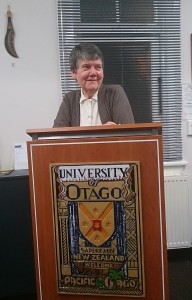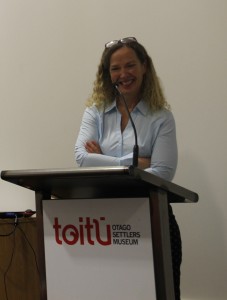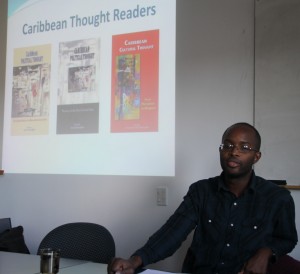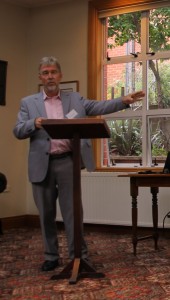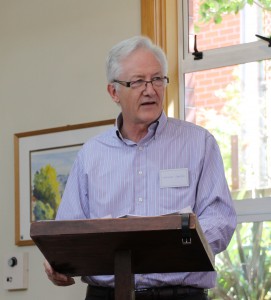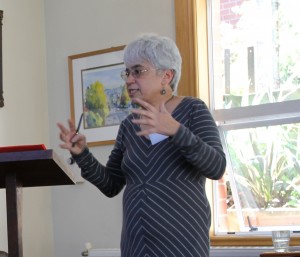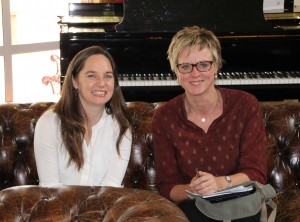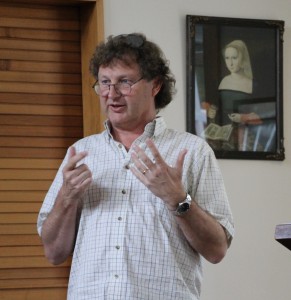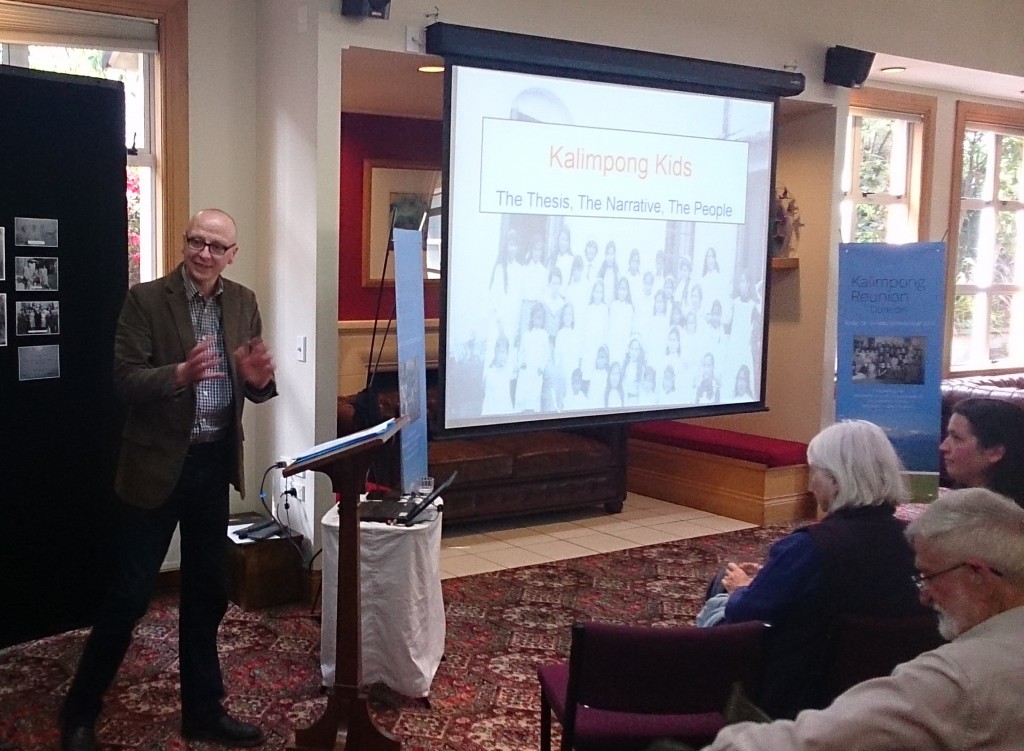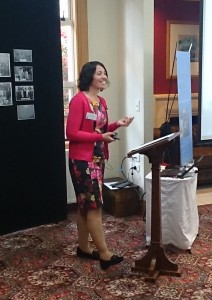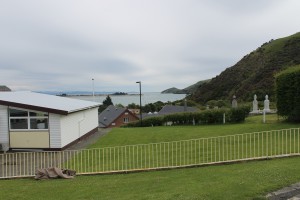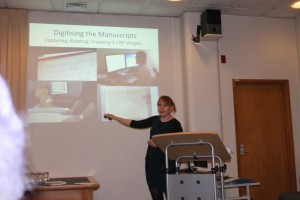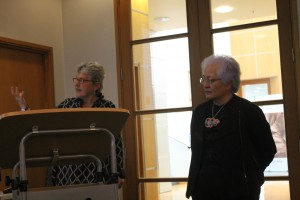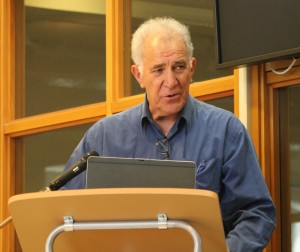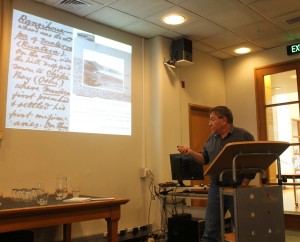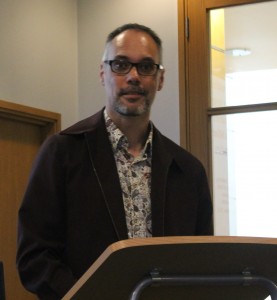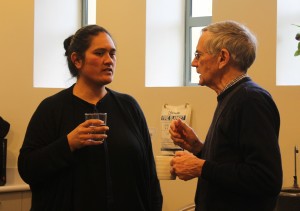Oceanian Journeys and Sojourns
An exciting new book, Oceanian Journeys and Sojourns: Home thoughts abroad, edited by Centre member, Professor Judy Bennett, was launched last night.
A good crowd squeezed into the Pacific Islands Centre at the University of Otago to attend this launch. Assoc Prof Jenny Bryant-Tokalau (Te Tumu) introduced the book, which “focuses on how Pacific Island peoples – Oceanians – think about a range of journeys near and far: their meanings, motives and implications.” The book, published by Otago University Press, is notable for having mostly authors who are Pacific Islanders, including a number of women.
Dunedin’s Genetic Inheritance and Caribbean Cultural Thought.
The Centre has recently hosted two riveting research-based talks.
The first, on Sunday 10 May, was part of the Centre’s ongoing project, Global Dunedin. Professor Lisa Matisoo-Smith, a biological anthropologist from Genetics Otago gave a public lecture at Toitū: Otago Settlers Museum, “Who do you think you are – Dunedin?”
Lisa discussed the genetic ancestry of Dunedin’s population based on the testing of randomly selected DNA samples. This research is part of the “Africa to Aotearoa” project, in which Lisa looks at the deep ancestry of New Zealanders, which in turn is part of a wider international study, the Genographic project, funded in part by National Geographic. While one might suspect that Dunedin’s genetic make-up is essentially homogenous from its Scottish heritage, the research shows just how diverse Dunedin’s population is, in line with other major cities in New Zealand.
On Thursday, May 15 visiting scholar Dr Aaron Kamugisha gave a CRoCC seminar, “The Caribbean’s Intellectual History through Culture”. Aaron discussed the global impact of Caribbean theorist’s, particularly CLR James, amongst others, on the development and dissemination of anti-colonial thought and intellectual traditions. He placed these theorists in the context of the development of two threads of intellectual history: Caribbean Studies and Caribbean Cultural Studies, but argued that these thinkers ought to be understood in term of Caribbean radical thought.
James Cowan Research now published.
“Born to a soldier-settler family at the end of a decade of colonial conflict, James Cowan grew up on the site of the Battle of Ōrākau. In the anxious years after the Waikato War, he learned the language and the stories of people on both sides. He went on to become a journalist and a historian of colonial New Zealand, and perhaps the most widely-read interpreter between Māori and Pākehā cultures in the first half of the twentieth century.”
In February 2014 a successful one-day conference on James Cowan and his impact was held at the Alexander Turnbull Library, jointly organized by Associate Professor Annabel Cooper from CROCC and Ariana Tikao, Research Librarian Māori at the Turnbull. Research from the conference has now been published (freely available online) in a special issue of the Journal of New Zealand Studies, “James Cowan and the Legacies of Late Colonial Culture in Aotearoa New Zealand”.
Eugenics in British Colonial Contexts
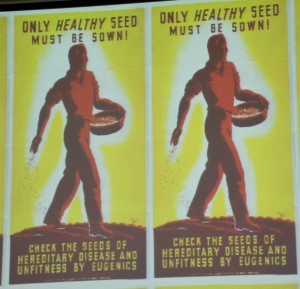 The Centre’s year has kicked off to a good start with “Eugenics in British Colonial Contexts: Australia, Canada, New Zealand and South Africa” in the comfortable facilities of St Margaret’s College, on 7-8 February. This single-stream conference was organized by Associate Professor John Stenhouse (History, and CROCC) and Professor Hamish Spencer (Genetics, and Allan Wilson Centre for Molecular Ecology and Evolution), and Professor Emerita Diane Paul (University of Massachusetts Boston, Research Associate, Museum of Comparative Zoology, Harvard University, and currently William Evans Fellow at Otago).
The Centre’s year has kicked off to a good start with “Eugenics in British Colonial Contexts: Australia, Canada, New Zealand and South Africa” in the comfortable facilities of St Margaret’s College, on 7-8 February. This single-stream conference was organized by Associate Professor John Stenhouse (History, and CROCC) and Professor Hamish Spencer (Genetics, and Allan Wilson Centre for Molecular Ecology and Evolution), and Professor Emerita Diane Paul (University of Massachusetts Boston, Research Associate, Museum of Comparative Zoology, Harvard University, and currently William Evans Fellow at Otago).
After the event was opened by PVC Humanities, Professor Brian Moloughney, Tony Ballantyne (Otago) spoke first on “Colonisation and the problem of Population”. Tony began with the question, when did the Eugenics begin in New Zealand, as its history has various possible beginning points. It was an issue that had significant discursive importance to the big questions of the day, in particular with regard to population, immigration, and political economy.
John Stenhouse (Otago) spoke on William Pember Reeves, the Liberal politician of the late nineteenth century. Reeves, celebrated for his Industrial Conciliation and Arbitration legislation, is less well known for his efforts to restrict the immigration of undesirables, including those deemed to be physically or mentally defective. Reeves was one step beyond public opinion, and his efforts stalled. A watered-down bill, principally anti-Asian, was more successful.
Sir Robert Stout, eminent New Zealand politician and jurist, was the focus of Emma Gattey’s (Otago) talk. A Freethinker and advocate of Darwin’s Theory of Evolution, Stout’s interest in eugenics is less well known. An active member of the Eugenics Society, Stout pushed for the segregation of mental defectives from society. Even his own daughter, an epileptic, was held at Seacliff Lunatic Asylum for a number of years.
Stephen Garton (Sydney) talked on the illiberalism prevalent in early twentieth-century Australia, a time now seen when medicine particularly infected by ideology. Ultimately, however, liberal safeguards survive and all efforts at sterilization of mental defectives fail in Australia, and without a scientific consensus, politicians were reluctant to pass contentious legislation. Jane Carey (Wollongong) took a wide view of the issue of eugenics, arguing that race, class and gender are interlinked into eugenist discourses. Eugenics is often seen in terms of national historiography, but was a transnational discourse. Although for some it was about the “English race”, others took a different view, prepared for example, to “breed out colour” through intermarriage.
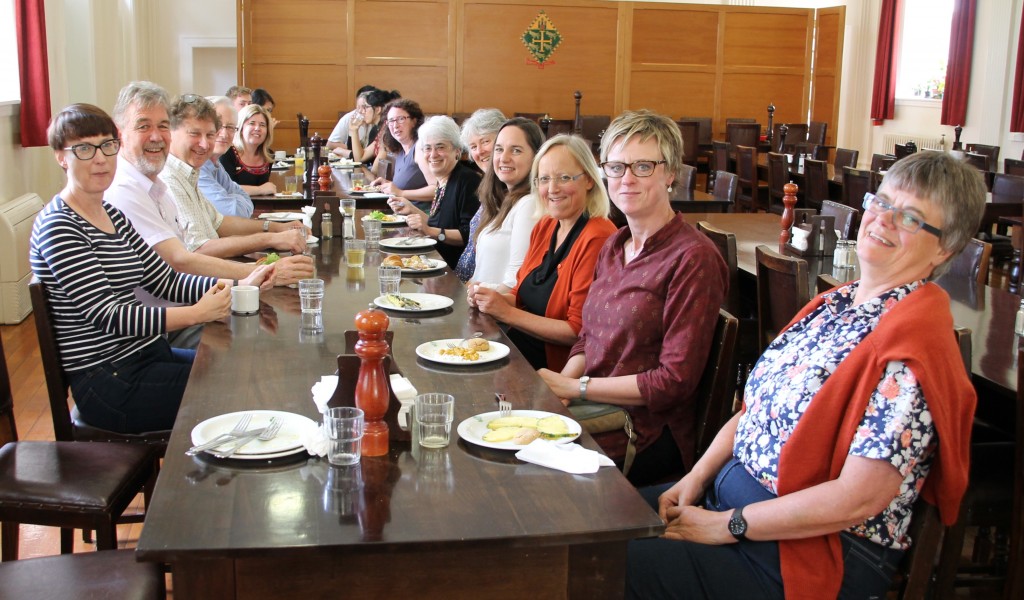
Click to enlarge. From left, Caroline Daley, John Stenhouse, Hamish Spencer, Stephen Garton, Angela Wanhalla, Jane Carey, Diane Paul, Barbara Brookes, Erika Dyck, Charlotte Macdonald, Susanne Klausen, Rosi Crane.
Baby contests began first in the US in 1854, but soon spread to other countries, including New Zealand. Caroline Daley (Auckland) discussed how initially these shows attracted considerable opposition, but they also appealed to those with proto-eugenic sentiments as indicators as to the quality of the racial stock. Shows took on a more scientific edge, with doctors weighing and measuring the babies. However, Caroline cautioned at reading too much into the eugenist angle, as consumerism was often a motivation for these events, and they continued to be held after eugenics declined in popularity.
Truby King is famous as a health reformer, both in terms of treatment of the mentally ill, and infants’ and children’s health, and as the founder of the Plunket Society that promoted his theory of mothercraft. Diane Paul (Massachusetts Boston) noted that more recently King (and the Plunket Society) have been labelled as eugenist. While it is possible to find some eugenist ideas in his writing, King was also critical of eugenics at times, believing that environmental factors, rather than hereditary, were more important, and how we classify King’s ideas really depends on how we define eugenics.
Susanne Klausen (Carleton) spoke first on the second day, looking at the impact of eugenist theories in South Africa that emerged in the late nineteenth century. One issue that troubled some in South Africa were the poor white Afrikaners, who migrated into the cities, living in slums together with black South Africans. Deemed as less intelligent than other whites, the Race Welfare Society tried to curb their high fertility rate. However, ultimately the eugenics movement in South Africa was relatively weak. In the face of large non-white populations, a white ethnic nationalism prevailed over biological imperatives, with poor white Afrikaners deemed salvageable in the interests of race unity.
Although eugenic discourses percolated through all of Canada, it was only in Western Canada that two provincial parliaments, in British Columbia and Alberta, passed laws legalizing sterilization of the mentally defective. Erika Dyck (Saskatchewan) discussed the situation in Alberta, where most of the sterilizations took place, between 1928-73. It was agrarian feminists who initially pushed for sterilization, but the legislation was strengthened by the Social Credit government, who removed informed consent. More recently it has been claimed that the government targeted indigenous women, but historical evidence for this is lacking, with indigenous health care, run by federal authorities, in general being provided at the most minimal levels.
Charlotte Macdonald (VUW) looked at the history of eugenic discourse in New Zealand. The high point of New Zealand eugenics was the Mental Defectives Amendment Act in 1928, which established a Eugenics Board. “Experts” could be powerful, for example Dr Theodore Gray, the Head of the Mental Hospitals Department, who recommended the sterilization of the mentally unfit, which became Clause 25 in the 1928 Bill. But this legislation was not palatable to all, and was watered down in its final form. Charlotte also looked at the Healthy Body Movement that appeared in a number of the “white” colonies in the 1930s. Although there is an assumption that this reflected eugenist ideas, this was not actually the case, although the perception may have led to its eventual demise.
Angela Wanhalla (Otago) discussed how marriage was also a concern in the discussion leading up to New Zealand’s 1928 legislation. The initial bill included Clause 21 that would have prohibited the marriage of the mentally or socially defective. While some newspapers were broadly supportive, the Anglican and Roman Catholic Churches opposed any state interference in the institution of marriage, and the Labour Party’s Peter Fraser led the fight against the worst aspects of the legislation in parliament. Eugenic discourse did influence divorce law, with insanity grounds to dissolve a marriage, although few used it due to the length of time required. New Zealand’s response was to segregate the mentally unfit rather than sterilization or marriage prohibition.
The last speaker, Hamish Spencer (Otago) also focused on the Mental Defectives legislation of 1928. The first Act, which distinguished between mental illness and defect, was passed in 1911. In 1924, a Committee of Inquiry convened to look into Mental Defectives and Sexual Offenders. A number of academics urged eugenic controls, such as the registration and sterilization of mentally defectives and immigration control, which the commission broadly agreed to. The 1928 legislation also came out of Dr Gray’s Report on Mental Deficiency, compiled after a world tour looking at how other countries dealt with the issue. As noted above, Peter Fraser was a vehement opponent of sterilization. Although the government had the support in parliament to pass this, it was not confident of wider public support and amended the original bill. But it was a very close thing.
All participants felt that this event was extremely productive. Despite differences in how each country applied eugenist ideas, the discourse was transnational. The organizers are now investigating publication options to get their research to a wider audience.
Dunedin: New Zealand’s history capital?
Jock Phillips, an eminent historian in both academic and public domains has just annointed Dunedin as the powerhouse of NZ historical research and scholarship. And this just days after Unesco named Dunedin a Creative City of Literature. Jock, until recently the Ministry of Culture and Heritage’s General Editor of Te Ara: the Encyclopedia of New Zealand has suggested in his latest blogpost that “New Zealand history moves south”, citing examples of the academic strength of historians at the University of Otago, its public institutions, such as Toitū: Otago Settlers Museum, as well as citizen-driven initiatives. Whatever aspect of history turns you on, Jock suggests that “Dunedin in 2015 is the place to be”. Click here to read Jock’s blogpost.
Colonial Worlds Elemental Histories Symposium
A one-day elemental histories symposium, a Centre for Research on Colonial Culture event, was held on 31st October, at the Hocken Collections. ‘Colonial Worlds Elemental Histories’ began with a keynote address from Grace Karskens, Associate Professor, UNSW. Her stories of early settlers (1802-1830s) who farmed the fertile but flood-prone Castlereagh region west of Sydney, revealed dogged determination in the face of repeated devastation. The settlers developed a culture of risk-taking and opportunity that underlay their fatalistic attitude towards the Australian bush.
Professor Tom Brooking’s paper ‘Yeotopia Gained: New Zealand 1840-1914’ explained how by 1914 most farming in New Zealand was carried out by family concerns but on someone else’s land. The changes in land ownership revealed a fracturing of a flawed dream.
‘Elementally United: The Case of Canterbury’s Nor’west Wind’ by Katie Pickles exhorted us to think with our senses. The wind, a dominant force in shaping emotion is both felt and seen in the landscape.
Dr Michael Davis’s paper entitled ‘Entangled Knowledges: Indigenous and Environmental Histories across the Tasman’, featured the botanical explorations and friendships between New Zealander William Colenso, Australian Allan Cunningham and Englishman Joseph Dalton Hooker.
In ‘Getting to Know You: People and Rabbits in Southern New Zealand’, Emeritus Professor Peter Holland presented a collation of information culled from diaries and ledgerbooks of rural farms and stations. Across southern New Zealand rabbit densities varied with swings in weather and climate, and interactions between people and rabbits changed.
By contrast Dr Vaughan Wood examined a single but detailed diary for his paper ‘Mapping the network of a nineteenth century Canterbury farm.’ He was able to plot, trips to the store, post office, friends and relations. Asymmetric patterns of movement across farms were governed by swampy land. These farming men, he concluded were an integral part of community.
After lunch Dr Michael Roche gave us an exposition on ‘The Forest as an Elemental Natural Resource in Colonial New Zealand and the First Failure of Scientific State Forestry, 1874 to 1877.’ These three years saw the introduction of scientific forestry brought by Captain Campbell Walker, who had a career with the Indian Forest Service in Madras and had studied orthodox German practice.
Continuing with the forestry theme Dr André Brett provided us with ‘Forests and Provincial Abolition: Did Conservation Kill the Provinces?’ Forest conservation enjoyed prominent supporters in the political and scientific communities during the provincial era, but it failed to capture the public imagination.
Dr James Beattie’s paper ‘Expanding the Horizons of Chinese Environmental History: Cantonese gold-miners in colonial New Zealand, 1860s-1920s’, used the experiences Chinese working alluvial gold in Otago to explain how their traditional knowledge of water management techniques coupled with hard work and tenacity changed the landscape. One entrepreneurial family Choie Sew Hoy was particularly important in the dredging boom of the 1890s.
PhD Candidate Lucy Mackintosh shared her research on Auckland’s several park-scapes. Her paper ‘Shifting Grounds: Narratives of Identity in Auckland Landscapes’ examined the urban environment with its monuments. ‘Our parks’ she claims ‘so often valued for their natural features, are also rich repositories of stories about the past.’
Continuing the theme of public spaces, Dr Joanna Cobley’s paper ‘The Nineteenth Century Landscape: economics, heritage and national identity’ looked at the heritage site of Tongariro National Park. Gifted to the nation in 1887 this first National Park is still viewed within the frameworks of useful and beautiful.
In the final paper of the day Eric Pawson ‘Writing environmental history’ asked the delegates for their input on an article he was finishing for the International Encyclopedia of Geography.
At a small function also held at the Hocken the book James Beattie and Matthew Henry launched their book Climate, Science, and Colonization: Histories from Australia and New Zealand, by James Beattie, Matthew Henry and Emily O’Gorman (eds). Palgrave MacMillan, London, 2014. Emily O’Gorman was unable to attend the function.
Thanks to Rosi Crane for supplying this report.
Kalimpong Reunion
A reunion was held today (28/11/14) at St Margarets College of descendants of migrants from the St Andrews Colonial Homes. The Homes, now known as the Dr Graham Homes, made up a boarding school in Kalimpong (West Bengal, India) mainly for children of indigenous women and European tea planters. Set up by Reverent Dr. John Anderson Graham in 1900, this Christian school educated the “Anglo-Indian” children, some of whom as teenagers were then sent to New Zealand between 1908 and 1938. The women worked as domestic servants, and the men as farm labourers.
The “Kalimpong Kids” were the subject of Jane McCabe‘s PhD thesis in the Department of History and Art History, supervised by Professor Tony Ballantyne and Dr Angela Wanhalla, both Centre members. The Centre has also supported the reunion, organised by Jane. About 65 descendants and family are attending and they have two days of planned events ahead of them.
Jane McCabe is herself a descendant of one of the original migrants, and her research involved contacting and interviewing some of the families. Her PhD was examined recently and judged “exceptional” by the examiners. Check out her website to find out more about her work.
Indigenous Mobilities Symposium
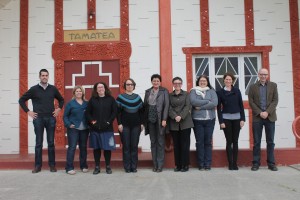
From left, Michael Stevens, Angela Wanhalla, Jane Carey, Kristyn Harman, Regina Ganter, Rachel Standfield, Shino Konishi, Tiffany Shellam, Tony Ballantyne. (Lachy Paterson photographer).
On Thursday and Friday (20-21 Nov) scholars assembled at Ōtākou marae, on the Otago Peninsula near Dunedin, for a pre-read symposium, “Rethinking Native Spaces: Indigenous Mobilities Across and Beyond the Antipodes”, co-organized by the Centre for Research on Colonial Culture of University of Otago and the Monash Indigenous Centre of Monash University. Attending were Tony Ballantyne, Michael Stevens, Angela Wanhalla and Lachy Paterson from CROCC and Rachel Standfield of MIC as well as Shino Konishi (University of Western Australia), Kristyn Harman (University of Tasmania), Tiffany Shellam (Deakin University), Regina Ganter (Griffith University) and Jane Carey (University of Wollongong). Unfortunately Lynette Russell of MIC was unable to attend. Research presented focused on a number of different aspects of Māori and Aboriginal travel in the colonial period, both within New Zealand and Australia but also further afield. A publication is planned. CROCC would like to acknowledge Rachel Standfield in particular for her hard work in bringing this event to fruition.
Speech to text: Missionary endeavours “to fix the Language of the New Zealanders”
A paper given by L.Paterson at the “Dialogues: Exploring the Drama of Early Missionary Encounters” symposium, Hocken Collections, Dunedin, 7-8 November, 2014.
In this paper I am looking mainly at Thomas Kendall, a member of the first batch of missionaries to New Zealand, and his efforts to create an orthography for te reo Māori. This is of course a topic that other scholars have covered in the past, not least Judith Binney and Jane McRae, but the theme of this symposium is “Dialogues: exploring the drama of early missionary encounters”, held as part of the launching of the new online archive of the Hocken Library’s Marsden Collection, so my paper makes an effort to utilize some of the discussions on orthography from that archive.
I perhaps need to state that I am a historian with some Māori-language skills rather than someone with expertise in linguistics, and I am straying a little outside of my normal period, the 1850s to the early twentieth century, to look at this early missionary period. It is also good that Kuni Jenkins and Alison Jones’s paper at this symposium on the early Missionary-Māori encounter, and their reflection on their 2012 book, He Kōrero: First Maori- Pakeha Conversations on Paper, gives a good insight on how Māori contributed to the development of the orthography. The archive, compiled from missionary letters and journals, is less revealing on their input. The “dialogues” that follow are largely between Thomas Kendall, an on-the-ground missionary, Samuel Marsden, his immediate superior in Sydney, and the Church Missionary Society officials in London. What these texts do showcase is the ease with which historical material can be gleaned from the wealth of material contained in the Marsden Online Archive.
One thing that was important to the early missionaries was to make the scriptures available to Māori in their own language. If Māori were able to read the Bible in their own language, then it would be easier to convert them to Christianity. For this to happen missionaries would have to learn not only how to speak the language, but also to develop a system for writing it down. This would then make it possible to teach Māori how to read, as well as to translate and print the scriptures.
Although not yet ordained, Kendall was the best educated of the missionaries, and as can be seen on a letter written to one of the CMS Secretaries when on his exploratory trip to the Bay of Islands in early 1814, he was well aware that the task would not be easy.
As far as I am concerned, I should know but little of myself, did I not feel conscious of my own inability. Even an attempt to fix the Language of the New Zealanders so that they may be instructed in their own Tongue is a great work; and cannot in the very nature of things be accomplished for some years to come…
[Thomas Kendall to Josiah Pratt, 25 March 1814. MS_0054_035and036.]
We can see here some of Kendall’s early efforts at collecting vocabulary from that first trip.
Ire mi kiki (Come & eat)
Haere mai kaikai [Haere mai [ki te] kai.]
Emmera Ho my why (Bring me some water)
E mara homai [he] wai.
Yahheeyahee pi (A fine night)
Ahiahi pai
[Thomas Kendall to Josiah Pratt, 15 June 1814. MS_0054_043.]
When you compare his renditions with how they might be spelled now (in italics) – we can see that he has utilized English vowel sounds in his spelling. However, he has not been consistent, for example writing the AI sound, as in kai, wai and pai, with either an I or a Y.
The whole process was going to be slow, but the CMS was hopeful. We can see here a letter from one of their secretaries less than a year after the mission was first planted expecting Kendall to be making a start at translating some scripture.
We shall hope to hear that you have made proficiency in the New Zealand tongue; and that the way will be thus prepared by you for the Translation of the Scriptures, when you are joined by a Clergyman who understands the originals. In the mean while we hope that you will prepare portions of Scripture, as well as you may be able; and that the little New Zealanders will, under your kind and paternal care, first learn the rudiments of their own tongue out of the Book of God.
[Rev Josiah Pratt to Thomas Kendall, 16 August 1815. MS_0055_019]
However, it was clear that they thought authorative translations were probably beyond Kendall’s skills, and a “real” clergyman who understood the Greek and Hebrew versions would be needed. By October, 1815 Kendall wrote back to Pratt ”I can speak to them in their own tongue, as yet, but very imperfectly” and he asked if a clergyman could come to help with “fixing the Native Language”. [Thomas Kendall to Samuel Marsden, 27 May 1815. MS_0055_012.]
No clergyman was as yet forthcoming, and in 1815 he produced A Korao no New Zealand, the first book produced for a Māori audience. His grammar is slightly better than his original collections, but we can see in an extract that his spelling continues on the same basis – using English vowels. The italicised text is as it would be spelled today.
Kámatte aou te eaki (I am very hungry)
Ka mate au [i] te hiakai.
Iremi taooa kekone kiei (Come let us sit down and eat.)
Haere mai tāua ki konei kai ai.
[T. Kendall, A Korao no New Zealand (1815)]
Kendall was not a trained linguist, and he wrote the sounds as he heard and understood them. Notwithstanding that Māori may have simplified their expressions to make comprehension easier for Kendall, as can be seen in an example he collected in early 1814.
Shoroe ahaw Dingha Dingha Matta
(Wash your hands and face)
Horoia ōu ringaringa [me tōu] mata.
[Thomas Kendall to Josiah Pratt, 15 June 1814. MS_0054_043.]
But why does it seem so different to modern Māori? We should compare his efforts with modern-day language learners. If you asked an average Japanese people today to say “red” he may well say “led” or “red”. That is because the Japanese language does not distinguish between these sounds, and either L or R can be used in Japanese without changing the meaning at all. Indeed, many Japanese people cannot really hear the difference. Similarly many English speakers have difficulty with other languages, such as Russian or Arabic, that distinguish between sounds that English does not.
Ngāpuhi simply did not differentiate between SH and H, or between D and R. Here in Southern New Zealand, Kai Tahu did not differentiate between L and R, which is why we have Lake Waihola just down the road. But H and SH sounds did sound different to Kendall, so he wrote them down as he heard them.
It is well known that Professor Samuel Lee, the famed linguist at Cambridge University, collaborated with Kendall, Hongi Hika and Waikato in 1820 to create an orthography for te reo Māori. But Lee’s involvement had began several years earlier. In 1818 Lee was already working on Māori grammar, with the aid of Kendall’s A Korao no New Zealand, as well as the services of two Māori travellers, Tuai and Tītere. [Edward Bickersteth and Josiah Pratt to Thomas Kendall, 12 March 1818, MS_0056_076]
It is clear too that Kendall was now leaning towards what were called the “continental” vowel sounds, such as used in Italian. In 1819 he wrote “The Taheitians … pronounce the sounds of the letters and vowels after a similar method very readily.” [Thomas Kendall to Samuel Marsden, 21 April 1819. MS_0056_150.]
Although the missionaries in Tahiti had serious disagreements about an orthography for the Tahitian language, one of their number, John Davies, had developed a system based on “continental vowels”, which Kendall was referring to (Davies, p.77). Kendall wrote later,
On the Sunday after easter I had an opportunity to examine some Taheitian sailors belonging to the Ship King George, and they read the Works of their Missionaries both in print & Manuscript very readily, whereas I am told, the Society Islanders [Tahitians] could never be taught by our [English-based] method.
[Thomas Kendall to Josiah Pratt, 20 May 1819. MS_0056_162.]
In another letter to Pratt he wrote,
Tell Mr Lee that in writing the New Zealand Language I have first fixed the Sounds of the vowels and then formed those sounds, without paying regard to the English or any other orthography.
[Thomas Kendall to Josiah Pratt, 17 May 1819. MS_0056_159.]
Several of Kendall’s manuscripts were subsequently sent to Lee and the CMS. The Secretaries wrote to Kendall,
The New Zealanders first Book [A Korao no New Zealand] has greatly pleased us. Our Orientalist, Mr Lee, is making use of Tooi & Teeterree (who have recently arrived) to form a complete Grammar & Vocabulary of the New Zealand Language.
[Edward Bickersteth and Josiah Pratt to Thomas Kendall, 12 March 1818. MS_0056_076.]
However Bickersteth and Pratt were a little more critical of Kendall’s efforts, when they wrote to Marsden.
Mr Kendall appears to have adopted too many marks of aspiration &c. His system would puzzle the New Zealanders. The whole will require deliberate investigation; and time spent herein in the outset will probably save a great deal in the end.
[Edward Bickersteth and Josiah Pratt to Samuel Marsden, 3 August 1819. MS_0056_188.]
So Hongi, Waikato and Kendall travelled to England in 1820, and while there they worked with Lee to work on an orthography, vocabulary and Grammar, published as A Grammar and Vocabulary of the Language of New Zealand in 1820.
Extract
T. Na tána wahíne ra óki i ó mai. Ke táwahi ra óki e O’ngi, ke Ingland. Ki á no koe i róngo nóa?
P. Ki a no ‘au i róngo nóa.
T. Kóa díro ke ráia; kóa tai ke, méa ka e óki mai.
P. A’i! k’wai tóna kaipúke i éke ai ía?
Modern orthography
T. Na tāna wahine rā hoki i homai. Kei tāwāhi rā hoki a Hongi, kei Ingarangi. Kianō koe i rongo noa?
P. Kianō au i rongo noa.
T. Kua riro kē rā ia; kua tae kē, meake e hoki mai.
P. Āe! Ko wai tōna kaipuke i eke ai ia?
Thomas Kendall. A Grammar and vocabulary of the language of New Zealand (1820).
We can see that there is a clear improvement on Kendall’s earlier work. However, the text still sports dropped Hs, and the use of both R and D. Although there are a few things that don’t look right, most of the vowels are pretty close to modern Māori.
Kendall clearly wanted to take the credit for what was clearly a collaboration between Lee, Hongi, Waikato and himself. He wrote to Pratt:
I thank you for indulging me with the privilege of the instruction of the Rev.d Professor Lee so long. I have now nearly completed my work. The Professor has assisted me very much I could not have done without him.
[Thomas Kendall to Josiah Pratt, 4 October 1820. MS_0498_094.]
So how did their efforts go down with the other missionaries? Kendall’s contemporaries did not like it at all, and their main concern appears to be with the use of the continental vowels. Marsden visited New Zealand in 1823. Kendall had been sacked at this point due to his adultery, and was waiting to leave New Zealand, but he had been told to draw up a vocabulary, using the English vowel sounds.
When I called upon you after our Shipwreck I advised you to employ your time untill [sic] an opportunity for our return to Port Jackson, in drawing up a vocabulary of the New Zealand language in as correct and simple a manner as you could retaining the pronunciation of the English Vowels, as I found the Missionaries met with insuperable difficulties in speaking the language according to the Rules laid down in your Grammer. [sic]
[Samuel Marsden to Thomas Kendall, 14 August 1823. MS_0057_098.]
The debate over English versus continental vowels also occurred in Tahiti, where John Davies was initially outvoted in his attempt to do away with the English vowels (Davies, p.78). As in New Zealand, his contemporaries thought learning a new system would be too hard.
Marsden writing in his journal declared the Grammar to be imperfect, and confusing.
The rules laid down in the Grammer [sic] for the Orthography and Pronounciation of the language is not simple enough for the Missionaries to comprehend— They cannot retain in their memory the sound of the vowels as laid down in the rules of the Grammer— and pronounce them as the Natives can understand them.
[Samuel Marsden’s Journal from 2 July 1823 to 1 November 1823. MS_0177_003.]
I do not see any good reason for changing the sound of the vowels as the New Zealanders can with so much ease sound all the English Alphabet— If in speaking and writing the N[ew] Zealand language the Europeans retain the English pronounciation, the whole difficulty of which they complain, will be removed.
[Samuel Marsden’s Journal from 2 July 1823 to 1 November 1823. MS_0177_003.]
Marsden met with Kendall, who admitted that even he could not follow all the rules. Marsden wrote,
It appeared to me absurd to study Mr Kendalls theory, which he himself could not reduce to practice.
[Marsden’s Personal Copy of the Journal of his Fourth Visit to New Zealand. MS_0177_004.]
Marsden also thought it better if Māori first learnt the English sounds, and then learnt the English language, especially as he thought the Māori language “unchaste”.
I also recommended that all the English terms for such things as the native had never seen, should be introduced into the N Zealand language, that a Sheep should be called a Sheep, a Cow a Cow &c.
[Samuel Marsden’s Journal from 2 July 1823 to 1 November 1823. MS_0177_003.]
Rev Nathaniel Turner, one of the Wesleyan missionaries in the Bay of Islands, also called on Marsden to complain about the 1820 Grammar. Marsden reassured him that it would be going back to the way it was. Turner “expressed much satisfaction” at retaining the English vowels. Marsden opined:
I hope this question will now be at rest, as all are unanimously of opinion that the Vowels should retain the English pronounciation [sic]
[Marsden’s Personal Copy of the Journal of his Fourth Visit to New Zealand. MS_0177_004.]
Marsden’s 1823 visit coincided with changes in the Mission. He brought Rev. Henry Williams to New Zealand and Williams soon after became the effective leader of the Mission. Less than six months after arriving, the new missionary had decided that Kendall’s grammar was a dud.
We, in Council, have condemned the book called “The Grammar.” I cannot tell what share Professor Lee may have had in the composition thereof, but it certainly appears far from simplicity.
[Henry Williams to the Rev E. G. Marsh, January 27, 1824, in Carleton, p.37.]
The Grammar did however made its way to Hawai’i, where the missionaries there may have used it, as they too grappled with creating an orthography for the Hawaiian language (Schütz, p.251).
Kendall was still living in the Bay of Islands at this stage, but away from the mission, and therefore sidelined from new developments in the orthography. Williams put more emphasis on learning the language, as his biographer suggested “not in the slovenly style in which it may be learned by conversation, but in a scholar-like fashion, ascertaining the rules by which it is governed, compiling a dictionary, and fitting themselves to undertake a translation of the Holy Scriptures” (Carleton, p.32). In this efforts he was helped by his brother William Williams who arrived in 1826, and Robert Maunsell in 1836.
Over the next few years there was a slow adaptation of Māori-language orthography. Take, for example this example from 1826: a Proclamation by the NSW governor.
Ná tóna Excelenei, iá Sir Thomasa Brisabane, ko te Captani, ko te tíno Rángatira wáka shau; o ténei káinga, o New South Wales, me óna tíne motu atu óki, &c. &c. &c.
II. Na te méa, e máha ngá páshua tanga o ngá Mótu, kí te Moana Pocifica; a, kí te Moana tudiana, e nga tángata kíno: á ko ugá [sic] tàngata shóko ká máte iá rátou;
[Books in Māori, 6]
The translation was probably done by the John Butler, who had been a missionary at Kerikeri, but by 1826 was living in NSW. We can see the use of some English words and names, and some of the consonants of the older orthographies, such as the W for WH, SH for H, and D for R.
This was also the case in the example below, an extract from the Wesleyan Methodist Mission version’s of the Lord’s Prayer also printed in 1826.
To matu Matua e noho’na koe i dunga ki te rangi, kia tabu tou ingwa. [Books in Māori, 7]
But it appears that any move to return to English vowels was now over. As we see from these scriptural selections below from 1829 and 1833, within a few years written Māori had almost achieved its modern form.
Ko te tahi o nga upoko.
1 I te orokomeatanga i hanga e te Atua te rangi me te ’wenua.
[Books in Māori, 9]
Ko te tahi wahi o te Kawenata Hou o Ihu Karaiti te Ariki, to tatou Kai Wakaora. Me nga upoko e waru o te pukapuka o Kenehi. Ka oti nei te wakamaori ki te reo o Nu Tirani.
[Books in Māori, 15]
What is notable is that the Williams brothers did not opt for English vowels, but continued with the continental vowels that the 1820 grammar had introduced. The new missionaries, such as the Williams brothers, were far better linguists than Kendall, and developed the orthography to its more usable form. They were aware that the Māori language did not distinguish between D and R, so opted just for the R. Similarly other unnecessary letters such as B, L, and SH were dropped. The one major exception that remained was the use of W or ‘W for the WH sound, as seen above. As Binney points out Kendall did attempt, unsuccessfully, to republish a revised grammar in the late 1820s, in which the WH sound would have been differentiated (Judith Binney. ‘Kendall, Thomas’, DNZB). But it was not until the 1840s that the WH was incorporated into the orthography. It is quite possible that regularizing the spelling, and the spread of literacy, has, over time, also had an effect on how te reo was pronounced, with sounds such as D and L falling out of favour.
In conclusion, Thomas Kendall was right in 1814 when he said that fixing the language would be a great work, and a task that would take some years to achieve. He struggled initially with his English ear, but together with Hongi, Waikato, and Samuel Lee, created an orthography in 1820 that went some of the way to finding a workable system. Their efforts were not appreciated by the other missionaries, who wanted to keep to the old style of writing Māori down. It was really the next wave of missionaries, better educated and more methodical in approach, who improved on Kendall’s work, translated considerable amounts of the scriptures, and who had the most success with their evangelical endeavours.
Carleton, H. The Life of Henry Williams, Auckland, 1874.
John Davies, A History of the Tahitian Mission 1799-1830, edited by C.W. Newbury (ed), Cambridge: Hakluyt Society, 1961.
Jones A. and K. Jenkins, He Kōrero: First Maori- Pakeha Conversations on Paper, Wellington: Huia, 2012.
Kendall, T. A Korao no New Zealand, Sydney, 1815.
Kendall T. and S. Lee, A Grammar and Vocabulary of the Language of New Zealand, London, 1820.
Parkinson P. and P. Griffith, Books in Māori 1815-1900: Ngā Tānga Reo Māori, Auckland: Reed, 2004.
Schütz, A. J. Voices of Eden: A History of Hawaiian Studies, Honolulu: University of Hawaii Press,1994.
Celebrating Marsden
It’s been a busy few days at the Hocken Collections with the events around the Marsden Online Archive launch and opening of the associated “Whakapono, Faith and Foundations” exhibition, timed to coincide with the bicentennial of the arrival of missionaries in New Zealand.
Considerable publicity had led to these events. For example:
Tony Ballantyne interview on National Radio
Television One News coverage (watch from 17.37)
Te Karere coverage (i roto i te reo Māori – in Māori)
For all the links see the Marsden Online Archive Storify page.
On Thursday afternoon Kāi Tahu and locally-based Northland Māori welcomed Hongi Hika, a self-portrait sculpture by the illustrious Ngā Puhi warrior. Bernard Makoare and Hinerangi Himiona of Ngāpuhi and Chanel Clarke, Māori Curator of the Auckland War Memorial Museum, accompanied this taonga who was installed in the Whakapono exhibition upstairs in the Hocken Gallery. Click here for the full story.
In the evening a good crowd assembled in the Hocken foyer for both the opening of the exhibition and the official launch of the online archive. The event was opened by David Ellison of the Puketeraki Rūnanka of Kāi Tahu, Bernard Makoare, and Kelvin Wright, Anglican Bishop of Dunedin. Particular praise was given to Gordon Parsonson, present in the front row of the audience, whose painstaking work transcribing the Marsden archives over many decades made the creation of the online archive possible.
The Marsden Online Archive was created by the University Library and Hocken Library, with considerable input from Professor Tony Ballantyne and the Centre for Research on Colonial Culture. This will be of great use to researchers interested in early missionary work, Māori-Pākehā interactions, and Māori culture.
The “Whakapono: Faith and Foundations” exhibition runs till 7 February, 2015.
The following two days were given over to “Dialogues”, a symposium on New Zealand’s early missionary history, held in the Hocken Seminar Room organised by the Centre and the Hocken Collections. This was kicked off with Cate Bardwell and Charlotte Brown of the University Library telling the story of how the Online Archive was created, followed with a demonstration of how to get the most out of the collection.
Three well-known religious historians, Allan Davidson (St Johns), Peter Lineham (Massey) and John Stenhouse (Otago) made up the next session. Allan talked on the “dialogue or disputation” in the first Wesleyan mission at Whangaroa; Peter discussed the Anglican moves into the Bay of Plenty/Waikato district in the 1830s, and how this lead to the sacking of the Matamata Mission Station in 1836; and John focused on Octavius Hadfield, his relationship with his Māori parishoners, and how this influenced his opposition to the Crown’s military actions.
After lunch Angela Middleton (Otago) gave an account of the powerful and influential Hariata, Hongi Hika’s daughter, informed by both historical and archaeological sources. Kuni Jenkins (Awanuiarangi) and Alison Jones followed on with a discussion their interpretation of the encounter at Hohi between Ngā Puhi and missionaries in December 1814. In the afternoon Donald Kerr gave an account of Dr Hocken’s collecting, and how he managed to amass so much of the original missionary papers, now housed in the Hocken Collections. Anna Blackman, the Archives Curator at the Hocken, then gave a talk on exploring the Marsden Collection, and earlier archival practice.
In the evening more people assembled for the launch of Angela Middleton’s new book, Pēwhairangi: Bay of Islands Missions and Māori 1814 to 1845. Manuka Henare (Auckland) formally launched the book, along with speeches by the Rachel Scott, Otago University Press publisher, Sharon Dell, the Hocken Librarian, and Paul Diamond, Curator Māori at the Alexander Turnbull Library.
Listen here to Angela’s Radio New Zealand interview, 4 November 2014.
Saturday was a shorter day. Ian Smith (Otago) gave an account of the archaeological dig and Hohi and how this informs our understanding of this first mission site and its inhabitants. Chanel Clarke and Rose Young (Auckland War Memorial Museum) discussed “Taonga Tuku Iho – Objects in Dialogue”, objects from their collection that spoke to the early interactions between missionaries and Māori.
After morning tea, Lachy Paterson (Otago) discussed Thomas Kendall’s dialogues with Marsden and the CMS on developing a working orthography for the Māori language. Paul Diamond (Turnbull) followed on, bringing to light a Māori vocabulary created by the Wesleyan missionary, Rev James Buller, in the 1830s and what this can tell us the Māori language of that time. After lunch, Tony Ballantyne (Otago) rounded off the symposium with a discussion on how applying new techniques from the field of digital humanities can give new historical perspectives, particularly when working with large collections.

